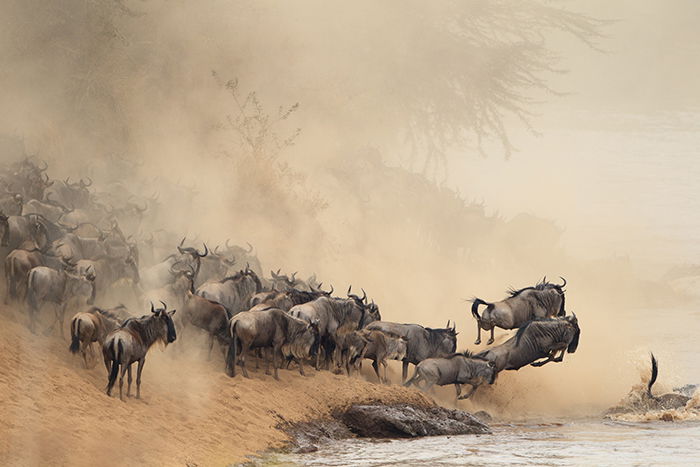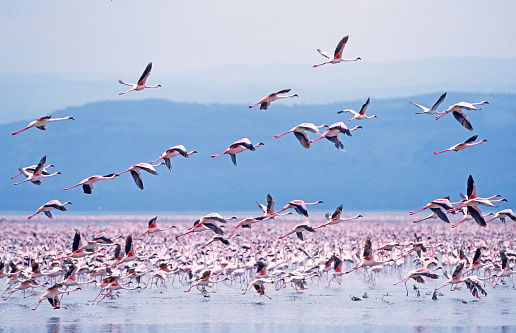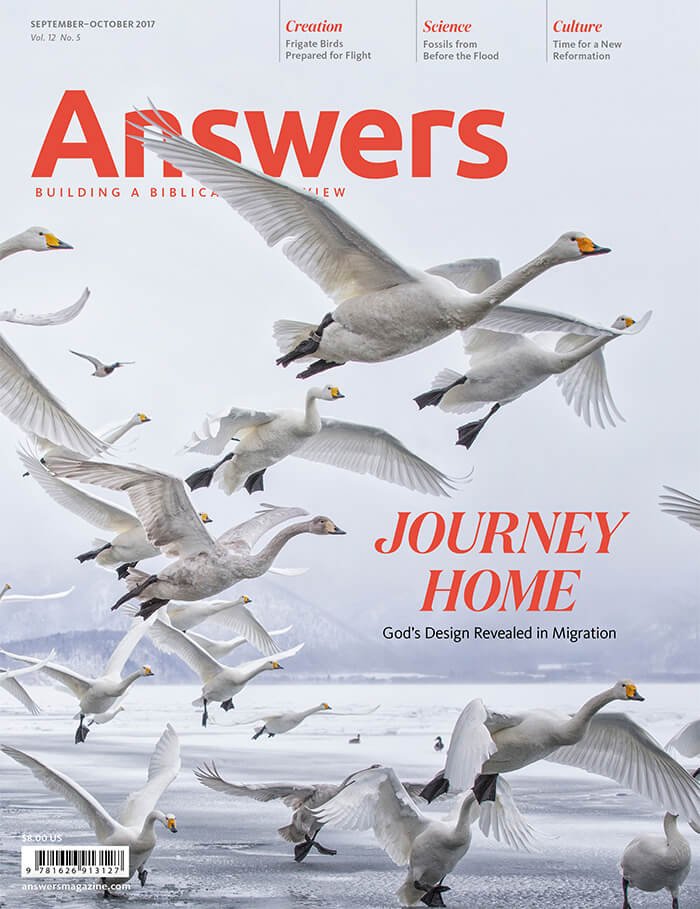
Journey Home—Astonishing Animal Migrations
Humans aren’t the only creatures constantly on the move. The Creator equipped numerous animals, large and small, with astonishing tools to find their way as they migrate around the world.
Marine biologist Charles Anderson went to the Maldives intent on spending his time in the water. The 1,200 tropical islands in this chain off India’s southwest coast provide the perfect environment for divers to study fish, mollusks, and especially blue whales. But one day, Anderson’s focus abruptly shifted from beneath the ocean to the surface.
Suddenly I noticed hundreds of dragonflies . . . they were there for some time, and then they were gone. And I didn’t think anything more of it until the following year when it happened again.
What’s so special about dragonflies on the Maldives? Dragonflies normally hover around freshwater, which they need to reproduce. But these tropical islands are built on coral reefs, so they lack freshwater at the surface. The insects shouldn’t be there. They should be on the mainland, where breeding pools are abundant.
As Anderson studied this strange phenomenon, he learned that millions of this type of dragonfly come to this unfriendly environment every year—wave after wave—around October. Then, just as quickly, they leave.
These dragonflies, called globe skimmers, seemed to fight against the prevailing winds to reach these islands.
The intrepid biologist began contacting other researchers in nearby areas to see if and when these insects might arrive at their locations. They came earlier in the season to Bangalore in the north, he found, and later to Malé in the south. What made the mystery more intriguing was that these dragonflies, called globe skimmers, seemed to fight against the prevailing winds to reach these islands. So they weren’t blown there by accident; they purposely flew there.
Why would ordinary dragonflies brave the monsoons to reach an island chain with little to offer them? The more Anderson researched, the more he saw a startling picture emerge. The two-inch Indian flyers weren’t coming there to live. They were simply stopping en route to a much more ambitious destination: Africa.
Anderson found that insects smaller than your hand make a circuit each year that takes them over 10,000 miles (16,000 km). That would be like taking two round trips from New York to California.
Why? Because—like many other living things—they’re designed to move.
On the Move

Driven to find fresh grazing grounds, more than a million wildebeests plunge through every obstacle on their annual 1,000-mile circuit of Africa’s Serengeti.
There and Back Again
Every year, millions of creatures—such as the globe skimmer—fly, hop, trot, and swim great distances as the seasons change. It’s a beautiful dance. Giant whooping cranes ride the winds south, wildebeests trample across Africa’s Serengeti, Christmas Island red crabs scuttle along beaches and streets, humpback whales sing on a loop around the Pacific Ocean, caribou herds race across Alaska, Adélie penguins march over the snow in Antarctica, and monarch butterflies swarm from Canada to remote trees in central Mexico.
Why do they go? Actually, the Bible tells us.
These creatures have a drive—an ingrained compulsion to find fresh food and safe nesting grounds. And that may mean winging or trotting or swimming thousands of miles each year. Why do they go? Actually, the Bible tells us. They go because the Creator designed them to multiply and fill the earth.
Many of God’s creatures have a roaming lifestyle: “Even the stork in the heavens knows her times, and the turtledove, swallow, and crane keep the time of their coming” (Jeremiah 8:7). Keeping track of time and location requires the animals and insects to have a remarkable combination of designs. These creatures can stay on course day or night, rain or shine—and some even change their bodies for differing environments.
Let’s get a bird’s eye view on how they do this.
Pink Patrol

Vast flocks of flamingos migrate from lake to lake in East Africa in search of algae that grows there in abundance. As many as two million gather at their favorite spot, Kenya’s Lake Nakuru.
Magnetic Sense of Direction
Researchers are still developing devices small enough to study insects, so our best resource to examine is birds. If there were a mascot for migration, it would probably be the bird. As far as we know, at least 4,000 species migrate, which is roughly 40 percent of all birds.
These aren’t just dainty little flights. Some of these birds push the limits. Arctic terns, for instance, flip the odometer by zigzagging 50,000 miles (80,000 km) each year from the Arctic to Antarctica and back. They time their flights to hit the long days at either pole, when food is ripe for the picking. Bar-headed geese easily hurtle over the Himalayas during their yearly migration, soaring up to five-and-a-half miles (9 km) above sea level. The great snipe puts the “pedal to the metal” during its migration and hits speeds of up to 60 mph (100 km/hr) for long stretches.
Unable to fly? No problem for Adélie penguins. These tuxedoed waddlers can swim 375 miles (600 km) from Antarctica to find their birthplace on remote islands in the Pacific, Atlantic, and Indian Oceans.
Even songbirds in your own backyard are more like Superman than mild-mannered Clark Kent.
Even songbirds in your own backyard are more like Superman than mild-mannered Clark Kent. Back in 2007, scientists fitted purple martins and wood thrushes with geolocating “backpacks,” and they discovered that these little birds fly up to 300 miles (480 km) per day on trips from the eastern US to South America’s Amazon basin.
How do birds know where they’re going, especially with such tiny “bird brains”?
Birds may have small brains, but even young birds can get to their winter resorts without anyone showing the way. The key is a comic-book-sounding ability called magnetoreception (mag-NEAT-oh-ree-SEP-shun) and an instinct to head south. Magnetoreception means being able to sense magnetic fields. That’s quite handy because our earth acts like a giant magnet with a north and south magnetic pole.
Migratory birds align themselves with magnetic south—we know this because they can be tricked by a fake south in the lab.
Migratory birds align themselves with magnetic south—we know this because they can be tricked by a fake south in the lab. Evidence shows that marine turtles, salmon, bats, rodents, red foxes, and even planthopper insects have this magnetoreception. Perhaps dragonflies do, too, but that hasn’t been proven.
Blanket of Butterflies

300 million monarch butterflies journey up to 3,000 miles (5,000 km) each year to a mountain retreat in Mexico. They never saw these grounds before, but they can track the earth’s magnetic field.
Dancing to the Rhythm of the Sky
But there’s more to “bird brains” than following magnetic fields from the north and south poles. If you trapped a Manx shearwater and transported it far from its nest, this seabird can simply fly in a circle long enough to figure out where it is and then fly straight home—even as far as from Boston to Wales.
How do they do it? They look up at the sun.
Many creatures use the sun or stars as a “compass,” including the famous honeybees. It’s one thing to know where to travel on a day’s expedition from the hive, but it’s another thing altogether to know when to migrate on a seasonal journey to another home.
Animals can’t pull up the calendar app on their smartphones to see what day it is and when they need to leave. But they have something better.
Animals can’t pull up the calendar app on their smartphones to see what day it is and when they need to leave. But they have something better.
Our planet tilts about 23.5 degrees. That slight lean causes the sun’s path to move ever so slowly through the sky over the course of the year.
Like sailors, many migrating creatures use objects in the sky as a directional guide. But whereas sailors rely on sextants, chronometers, and charts (or computers nowadays) to plot a course, God gave animals and insects the nifty ability to do geometry without the help of instruments. Instead, the complex equations and tools are built right into their internal clocks.
As the sun progresses through the sky, migratory animals recognize the changes via their internal clocks. In mammals, shorter days mean less light enters their eyes and stimulates the part of their brain that processes light signals. This part of the brain is called the suprachiasmatic nucleus (SCN). The SCN tracks the amount of daily light and produces a special mix of proteins when it’s time for the animal to scoot. (All mammals and insects have a mechanism like this to help them distinguish day and night, but migratory animals use this to help them know when it’s time to travel.)
Migrating insects have a similar mechanism, though the details vary from insect to insect. In monarch butterflies, for example, their “sun compass” depends on an internal clock built into their antennae. Scientists also suspect that dragonflies, such as globe skimmers, rely on a similar design to get them from India to Africa.
The moon can work just as well as the sun. Newly hatched sea turtles rely on moonlight to find the ocean (and they switch to magnetoreception once they’re out to sea). To test this skill in birds, some creative researchers released garden warblers inside a planetarium and then spun the stars on the screen. The birds faithfully headed “south” depending on what star configuration was projected above them.
My, How You’ve Changed!
Researchers are looking for ways to study other animals, too. Experiments seem to indicate that salmon use visual cues and their internal clocks to guide them on their epic migratory swim. But what happens to the salmon during this journey is even more fascinating.
Even in our fallen world, migratory creatures show remarkable designs that allow them to find their way.
Salmon migration upstream sounds exhausting. First, the silvery fish make their way through the ocean to the stream where they were born (in fact, some experiments indicate they may smell their way to it). Once they find it, they push against the current for many miles, leap over rocks, jump up waterfalls, dodge bears, ride fish elevators, avoid crafty fishermen, and finally make it to the calm pools where they can lay their eggs.
The trip has the added challenge of requiring the salmon to jump from freshwater to salt water (as a hatchling) and then back again. Most fish would die switching from one kind of water to the other, but the salmon is designed to transform as it travels. As daylight hours increase, the young salmon’s brain produces a special chemical that prepares its body for the open sea.
The smolt (as it’s called) loses its camouflaging bars, and then it moves down the stream and stays near the edge of the ocean for several days. While there, it gradually begins to drink less water because drinking seawater would cause too much salt to build up. The salmon’s kidneys slow down and excrete less urine—but it’s more concentrated; and its gills adjust to handle the brine.
Amazing physical change isn’t restricted to fish—even large mammals get into the transformation act as they’re on the move.
Amazing physical change isn’t restricted to fish—even large mammals get into the transformation act as they’re on the move. Among these, Arctic caribou are the stars. They migrate farther than any other land-dwelling animal—as far as 3,100 miles (5,000 km) each year. Over the months, their footpad size varies to handle the changing ground cover. In summer months they require larger, sponge-like pads to navigate the wet, slippery ground. In the winter, the pads shrink so the sharper hooves can grip the ice.
Mighty Mammals on the Move

Herds of caribou migrate farther each year than any other land animals—as far as 3,100 miles (5,000 km). In summer, their footpads grow large and spongelike to navigate the slippery ground. In winter, the pads shrink so their sharp hooves can grip the ice.
A Designer Move
These are just a few of the myriad designs God has given to his world travelers. The next time you see a flock of migrating ducks overhead or glimpse a pod of dolphins leaping beside your boat, remember who designed these creatures so they could find their way to the ends of the earth and bring glory to their Maker.
Getting to the right place—on the right day—isn’t a simple matter of flapping wings, swishing tails, or moving legs. Millions of miniscule reactions in each creature’s brain and body allow it to undertake its incredible journey.
God in his wonderful plan made all of his creatures with everything they need to fulfill their purpose, including us. That’s the lesson the prophet Jeremiah wants us to learn from migratory animals: “Even the stork in the heavens knows her times” (Jeremiah 8:7).
Related Videos
Golden Plover
Answers Magazine
September–October 2017
The Creator equipped numerous animals with astonishing tools to find their way as they migrate around the world.
Browse IssueRecommended Resources

Answers in Genesis is an apologetics ministry, dedicated to helping Christians defend their faith and proclaim the good news of Jesus Christ.
- Customer Service 800.778.3390
- Available Monday–Friday | 9 AM–5 PM ET
- © 2025 Answers in Genesis



